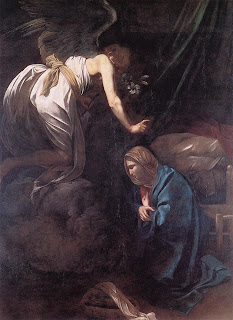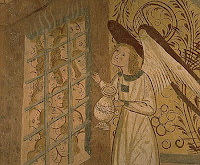 Comienza el tiempo de Adviento y con él la Iglesia inicia unas semanas de profundo y reverente silencio para preparar la celebración del nacimiento de Jesús[1].
Comienza el tiempo de Adviento y con él la Iglesia inicia unas semanas de profundo y reverente silencio para preparar la celebración del nacimiento de Jesús[1].Posiblemente todo lo que escuchemos a lo largo de éstos domingos en la liturgia nos suene a aguapasada, a cosas ya muy sabidas e incluso aburridas, sin embargo se hace cada vez más necesario el recordar y volver a insistir en que lo importante –lo esencial- de todo éste tiempo no es lo exterior o lo material, sino lo interior y lo espiritual: la apertura que cada uno tengamos hacia la celebración del nacimiento de Jesucristo.
El Adviento –éstas cuatro semanas que la Iglesia nos propone para preparar la alegre fiesta de la Navidad- pasa rápidamente, y si no estamos atentos, llegaremos a la Nochebuena tan llenos de vacío –o de nosotros mismos, que es mucho peor- que la celebración del Nacimiento del Señor será una fiesta más, una noche más, una oportunidad más para comprar, para gastar, para abrazar o para comer y beber en exceso.
¿Se trata entonces durante éste tiempo de encerrarse en un monasterio a pan y agua y absoluto silencio como hacen los cartujos?[2] Mala idea no es, sin embargo como Dios no hace con sus hijos cosas raras, y además no saca a nadie de su sitio, allí donde nos ha puesto –la parroquia, la oficina, la escuela- allí debemos prepararnos, sin prisa pero sin pausa, para celebrar una Nochebuena cristiana, una Nochebuena alegre y sobria, una Nochebuena en la que realmente recordemos lo esencial: el nacimiento de Jesucristo.
[Hemos de reflexionar en que] la Nochebuena nos presenta un Dios distinto, y un Hombre distinto. En el tiempo de Navidad descubrimos que Dios, mucho antes que el poder absoluto es el absoluto amor[3]. En Nochebuena, muere el dios de los filósofos o el dios castigador y temerario, y aparece el Dios todo-enamorado, y por tanto, todo-débil, todo-entregado en manos de su hijo, el hombre. La Navidad, si nos preparamos bien, nos mostrará que la verdadera grandeza de Dios no está en haber creado el mundo, sino en su disponibilidad para renunciar a su grandeza por amor, ¡ese es el milagro de los milagros! Y cada uno de nosotros estamos llamados ¡y capacitados! Para repetirlo.
El tiempo de Adviento nos recuerda a cada uno, que el hombre es nada menos y nada más que ¡capaz de Dios! y nos invita a estirar, a dilatar nuestro corazón hasta el infinito[4].
Cada Nochebuena no solamente Dios está con nosotros sino que está en nosotros, es cada uno de nosotros. Vale la pena pues detenernos unas semanas, y en medio de un silencio profundo y lleno de reverencia prepararnos bien para la celebración del Nacimiento de Jesucristo, Dios y Señor nuestro.
[1] Homilía pronunciada el 2.XII.2007, primer Domingo de Adviento, en la parroquia de St. Matthew, en San Antonio (Texas).
[2] San Bruno fue el fundador del primer monasterio llamado "la Chartreuse". Fue edificado en 1084 con la ayuda de otros seis compañeros, en un lugar montañoso y solitario, a pocos km de Grenoble (Francia). Los cartujos llevaban una vida de contemplación y de retiro pero no necesariamente sus monasterios estaban construidos en lugares apartados y recónditos. El aislamiento lo daba el propio edificio y sus dependencias estructuradas especialmente con este fin. El cartujo se acuesta muy pronto, entre las siete y media y las ocho de la tarde. Cuatro horas más tarde, a las once y media de la noche, se levanta y comienza su jornada. Después de asearse y de orar un rato en el oratorio de su ermita, a las 0,15 horas, la campana de la torre convoca a los monjes a la oración de la noche en la iglesia; son los Maitines y los Laudes, oración cantada, compuesta de salmos, lecturas de la Sagrada Escritura y de los Santos Padres, preces y oraciones por las necesidades del mundo y de la Iglesia. Este largo oficio litúrgico de la noche es muy apreciado por los monjes y se prolonga hasta las dos y cuarto o las tres de la mañana. De vuelta a su ermita el cartujo hace una breve oración a la Virgen María en su oratorio y se acuesta sin tardanza. A las seis y media de la mañana se levanta y dedica esas primeras horas a la oración. A las ocho se reúne la comunidad en la iglesia para la Misa, que siempre es cantada. La mañana transcurre en la ermita dedicada al estudio, la lectura meditada de la Sagrada Escritura, el trabajo manual. La comida es a las once y media y la tarde sólo se interrumpe para cantar en la iglesia el oficio litúrgico de Vísperas.
[3] Dios quiere nuestro amor y no estará satisfecho con ninguna otra cosa. El amor de nuestros corazones es algo único que ningún otro puede darle. Él podría hacer otros corazones que le amasen, pero una vez que nos ha dado la libertad, el amor de nuestro corazón particular es algo que sólo nosotros podemos darle” (E. Boylan, El amor supremo I, Madrid, Rialp 1957, pág. 121).
[4] La razón más alta de la dignidad humana consiste en la vocación del hombre a la comunión con Dios. El hombre es invitado al diálogo con Dios desde su nacimiento; pues no existe sino porque, creado por Dios por amor, es conservado siempre por amor; y no vive plenamente según la verdad si no reconoce libremente aquel amor y se entrega a su Creador (GS 19,1).
Ilustración: CARAVAGGIO, The Annunciation (1608-09), Oil on canvas, 285 x 205 cm, Musée des Beaux-Arts (Nancy).
Caravaggio probablemente realizó ésta obra durante su último periodo en Nápoles, por lo tanto quizá sea uno de los últimos trabajos del artista para el altar mayor de la catedral de Nancy (Lorrain). Pintada en Sicilia o en Nápoles -auctores disputant- está claro que es una de las últimas obras del autor. Llama la atención la manera en la que el ángel aparece en el cuadro: una forma distinta a como se había representado a lo largo de todo el barroco; la cara del ángel es prácticamente invisible. Por su parte la Virgen no lo mira, sino que está completamente absorta y en una actitud de alegre aceptación de un futuro hasta ése momento incierto. Una vez más Caravaggio nos sorprende con una imagen en la que la Virgen no aparece representada con atributos divinos o sobrenaturales, sino como una sencilla persona recogida en oración, preparando de inmediato la próxima venida de su Señor.










